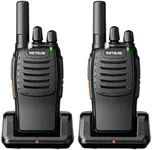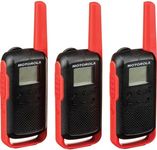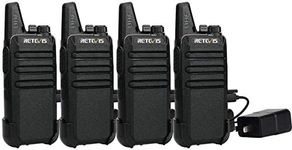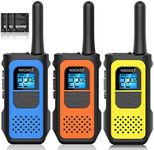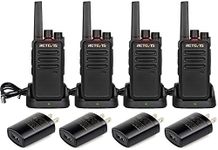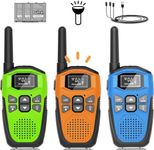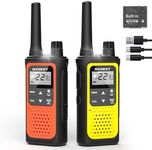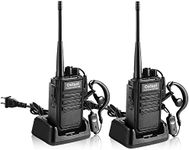Buying Guide for the Best Range Walkie Talkies
Choosing the right walkie-talkie can make a big difference in how well you can communicate over distances, whether you're hiking, camping, working on a job site, or just having fun. The key is to match the features of the walkie-talkie to your specific needs and environment. Understanding the main specifications will help you pick a model that offers the right balance of range, clarity, battery life, and ease of use for your situation.RangeRange refers to the maximum distance over which two walkie-talkies can communicate clearly. This is important because it determines how far apart you and your group can be while still staying in touch. Manufacturers often list the maximum range under ideal conditions, like open fields with no obstacles, but real-world range is usually less due to buildings, trees, and hills. Short-range models (up to 1 mile) are good for indoor or small outdoor areas, mid-range (1-5 miles) work well for parks or neighborhoods, and long-range (5 miles or more) are best for open areas or when you need to cover a lot of ground. Think about where you'll use the walkie-talkies most often and choose a range that fits those conditions.
ChannelsChannels are the different frequencies that walkie-talkies use to communicate. Having more channels means you have more options to avoid interference from other users, which is important in crowded areas or during group activities. Basic models may have a few channels, which is fine for small groups or quiet areas, while advanced models can have dozens, which is helpful for larger groups or busy locations. If you expect to use your walkie-talkies in places with lots of other users, or if you want privacy, look for models with more channels.
Battery LifeBattery life tells you how long the walkie-talkie will work before needing a recharge or new batteries. This is crucial if you'll be away from power sources for a long time, like on camping trips or during long work shifts. Some walkie-talkies use disposable batteries, while others have rechargeable ones. Short battery life (a few hours) is fine for quick outings, medium (8-12 hours) works for day trips, and long battery life (over 12 hours) is best for extended use. Consider how long you'll need your walkie-talkies to last between charges and pick accordingly.
Durability and Weather ResistanceDurability and weather resistance refer to how well the walkie-talkie can handle drops, dust, and water. This is important if you'll be using them outdoors, in rough conditions, or with kids. Some models are basic and best for indoor use, while others are rugged and can handle rain, splashes, or even being dropped. If you plan to use your walkie-talkies in challenging environments, look for models that are labeled as water-resistant or shockproof.
Size and WeightSize and weight affect how easy it is to carry and use the walkie-talkie. Smaller, lighter models are easier to carry in a pocket or on a belt, which is great for hiking or kids. Larger models may have more features or longer battery life, but can be bulkier. Think about who will be using the walkie-talkies and how portable you need them to be.
Ease of UseEase of use covers how simple it is to operate the walkie-talkie, including the buttons, display, and menu. This is important if you want something straightforward for kids or quick communication, or if you need advanced features for more complex needs. Simple models are best for beginners or casual use, while more advanced models may have extra features like privacy codes or group calling. Choose a model that matches your comfort level with technology and your communication needs.

